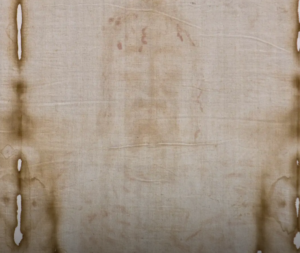what is the shroud of turin
The Shroud of Turin, a 14-foot linen fabric bearing the image of a crucified person has become a popular Catholic symbol. Some believe it to be the original burial shroud for Jesus Christ. Others, however, see it as a religious symbol that tells the story of Christ and not necessarily an original shroud.
The Shroud of Turin is still a religious symbol of importance for Christians all over the world, more than 600 years after its first appearance in history records.
1. The first shroud was discovered in France during medieval times.
In the early 1350s, the Shroud of Turin was first recorded in Lirey France. Geoffroi de Charny, a French knight, allegedly gave it to the dean at the Lirey church as Jesus’ burial shroud. It’s not known how de Charny obtained the shroud or where it went during the 1300 years that passed since Christ was buried outside Jerusalem.

2. The Pope declared that it was not a real historic relic.
The church in Lirey began to attract a large number of pilgrims and a great deal of money after displaying the shroud. Many prominent members of church were still sceptical about its authenticity.
Pierre d’Arcis, the bishop of Troyes in France, sent a report around 1389 to Pope Clement VII claiming that an artist confessed forging the shroud. D’Arcis also claimed that the dean at the Lirey Church knew the shroud was a fraud, but had still used it for fundraising. The pope responded by declaring that the shroud was not the burial cloth of Christ. He said that the Lirey Church could display the shroud if they acknowledged it was a religious “icon” made by man, not an historic “relic.”
3. De Charny’s granddaughter was excommunicated after selling it to Italian royalty.
When the Hundred Years’ War threatened Lirey in 1418, Geoffroi de Charny’s grandson Margaret de Charny offered to store cloth at their castle. Her husband signed a receipt acknowledging the fact that it wasn’t Jesus’ burial shroud and promised to return it when the situation was safe. She refused to return the shroud and took it on a tour instead, promoting it as Jesus’ burial shroud.
Margaret de Charny traded the shroud for two castles in 1453 to the Savoy royal family, which controlled parts of France, Italy, and Switzerland today (the Savoy house would later ascend to the Italian throne). She was excommunicated for selling the shroud.
4. The shroud was almost destroyed in a fire before it moved to Turin.
In 1502, Savoy’s house placed the shroud at the Sainte-Chapelle, in Chambery. Today France is part of this area. In 1532, the chapel caught fire. The fire melted a part of silver from the container that protected the shroud. This silver then fell on a part of it, burning it through. Burn marks and water stains are still visible where the fire was put out.
The house of Savoy relocated the shroud in 1578 to the Cathedral of Saint John the Baptist, Turin. Turin later became part of Italy. Since then, it has been there, except for World War II when Italy moved it to a safe place.
5. Many scientific studies have been conducted to verify its authenticity.
The debate over the authenticity of the shroud has continued despite the fact that Pope Clement VI declared it a fake more than 600 years ago. In the 20th century, both sides began to use scientific studies as evidence for their arguments.
The Shroud of Turin Research Project in the 1970s said that the markings were consistent with the marks of a crucified corpse and the stains on the cloth were made of real human blood. In 1988, a group of scientists claimed that their analysis indicated the shroud was created between 1260-1390, , while another stated their analysis revealed it to be between 300 B.C. A.D.400. Researchers in 2018 used forensic techniques to argue that the bloodstains on the shroud could not have come from Christ.
6. Bulletproof glass protects the shroud.
The fragile Shroud of Turin is under strict security. The Shroud of Turin is not often shown in public and is protected by bulletproof glass and security cameras. In 1997, the Cathedral of Saint John the Baptist caught fire. The bulletproof glass was a major roadblock. The shroud was saved by firefighter’s hammering through 4 layers of bulletproof glasses.
read more about what is the shroud of turin made of
7. The digital age has brought the shroud into existence.
Turin Archbishop Cesare Nassiglia announced in April 2020 that people from around the globe would be able to view the Shroud of Turin on the internet during Easter. Italy announced 143 626 COVID-19 cases and 18 279 deaths on the Thursday prior to the holiday of 2020. The Archbishop of Nosiglia stated that he decided to livestream the shroud because thousands of people requested it during the COVID-19 global crisis.
what is the significance of the shroud of turin
The Shroud of Turin, a linen cloth with an image of what appears to be a crucified man, is made of linen. The Shroud of Turin is important for many reasons.
- Religious Importance For many Christians the Shroud represents the burial cloth for Jesus Christ. Some see its image as a powerful representation of Jesus’ suffering and resurrection. It is a place of pilgrimage and religious veneration because people believe this.
- The Shroud’s historical and scientific interest has fascinated historians and scientists alike. Study and debate continue to be held on the origins of the cloth, its dating and the nature of its image. Carbon dating was used in scientific investigations, and it suggested that the cloth had a medieval (between 1260-1390 CE) origin. However, this conclusion has been disputed by some researchers. Some studies explored the possibility that the image was formed by natural processes, or by a type of energy release.
- Cultural and Artistic Impact The Shroud is a source of inspiration for artists and writers, as it has inspired countless depictions of Christ crucified in literature, art, and the media. The Shroud’s mysterious nature also contributes to its status as a source of fascination and speculation.
- Mystery: The Shroud is still a subject of controversy. Some believe it to be a genuine relic from Jesus Christ, while others claim it’s a medieval forgery. Scholars, theologians and the general public continue to be involved in this controversy.
The Shroud of Turin is a fascinating subject for study and devotion because of its complex mixture of religious, cultural, and historical significance.



One Comment on “The Shroud of Turin: 7 Intriguing Facts”